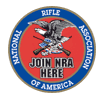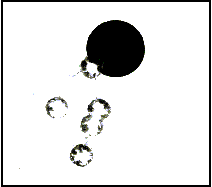
| Articles | Documents | Equipment | Events | Links | Membership | Miscellaneous | Scrapbook | Targets | What's New |
| Random Shots | June 1996 | |
| Gerhard Schroeder
| ||
I was out really early one morning last summer, after rabbits. I had an opportunity to test and compare three scopes: the Leupold Vari-X III 3.5-10x50 EFR (Extended Focusing Range, as in from 15 ft. to infinity); a Redfield Ultimate Illuminator 3-12x56 AO; and a Tasco World Class 6x40. The results at early dawn, or basically in still darkness, were clear-cut: Leupold best, Redfield good, Tasco worthless. However, as daylight increased, the differences dwindled quickly. Don't get me wrong, the Leupold was a jewel even in bright Arizona daylight, but the Tasco did fine then, too. Sorry to say that I had to let go of the Leupold, my brother in Germany considered it a keeper as well. In fact, he had ordered it, with the German #4 reticle, after reading test results there that indicated that the Leupold, however only the Multicoat 4 models, had basically the same optical performance as top notch performers such as Zeiss and Swarovsky. The results were similar for a Leupold 6x42, the only non-Vari-X III with the Multicoat 4, and a Tasco 2.5-10x44, when I tested them late in the evening. There wasn't much difference at daylight, but after sunset the Leupold was the one to have. There's actually a little more to the light versus no light scenario. Even with the sun (still) up, the Leupold gives better results when viewing objects that are located in the shade of either mountains or trees. Only in bright light does the advantage over the others fade. Remember the NRA show in Phoenix? Weaver had a display comparing their scope to the others, all more expensive. They chose a well-lit place to "look at" when you looked through them all. I wonder what the result would have been if they had aimed at a shady place in the rafters.
New Toy A few years ago I added a Van Horn bull barrel to my Contender equipment, 26" long, chambered in 7TCU. No practical hunting value, although some rabbits would argue that, if they could. It's primarily a plinker with double duty at the club's rifle silhouette event. I liked it, which was easy when the first group from it resulted in a one-hole affair. Enough to buy a second T/C frame and keep it as a permanent rifle. But I was still hungry -- hungry for a bolt action. The choice of calibers settled on .223 Remington. Why? Because I wanted to shoot it a lot, and keep both recoil and cost down. For the .223, brass is free from the desert, powder consumption is manageable, and the FMJ pills are the least expensive jacketed projectiles around. I also wanted a sporter with a short barrel, not a Varmint heavyweight. The 7TCU is my heavyweight. While it would be a decent rifle for hunting small stuff, the .223 is really only a toy. It's not even allowed at our club silhouette shoots. Through the newspaper I found an Interarms Mini Mauser. It has a nice custom wood stock under the 20" barrel without sights. What really made me buy it was the fully adjustable trigger and its price which was about a hundred bucks less than a new Ruger Ultralight. Quite frankly, its action stinks because it binds easily, particularly when you operate it fast, something I didn't notice until a got home. But damn, does it shoot! How about 5 shot groups of less than one inch @ 100, and 1.8 inch at 200 yards? Load was the Sierra 55gr HPBT, set in motion by 25.4 gr of AA2230 (this load sometimes even goes under half an inch, but not always). And even better, Glenn Sampson recommended a load of 24.5 gr of BLC-2 under the Winchester 55gr FMJ that also does about one inch. Plus I can keep shooting. Accuracy and point of impact won't change when the metal heats up, really heats up! Both the T/C and the Mini Mauser allowed a sweeping win at Bob Stoltz's Centerfire Fun Shoot. And the competition included such jewels as a Remington 700 Heavy Varmint, and Ruger's latest heavy Varmint, featuring 24 power optics. But the Mini took the highest single score, at 100 yards (1700 points). Scope was fixed power Leupold 6x42. Despite the rough action, the gun is a keeper, and I guess I'm well on my way now to wearing out its barrel, shooterholic style.
Crossed Sticks The practical test went like this: sitting in a beach chair, and resting the gun on the sticks while holding it all together with my left hand, I figured out how high to hold while shooting at a ½ gallon plastic jug. That done, with the scope set at 8 power, it took me three shots to nail a water-filled 46 oz. juice can, a 4¼" x 7" target, at 500 steps. Yep, that is the distance where the centerfire rifle steel rams roam. And the Mini Mauser did in three regular soda cans at 250 steps with 5 shots using the sticks and FMJ ammo. Might have to get used to a bipod after all. Anybody have any recommendations as to model and features? By the way, the .223 blew up those cans at 250, but the 7TCU only punched a hole through the tin can at 500. The can flipped, but didn't even swell a little. Load was a Sierra 100gr HP on top of 28gr of AA2015BR. It's still accurate out there, but gutless. Probably nothing is impressive with regard to power from a 7TCU after 400 paces. I use that gun for the centerfire rifle silhouette shoots. Critters up to turkey drop when hit, but not so the ram. Several that got hit were stubborn and didn't fall. But then, neither does a .243 Win slay steel rams consistently. And in comparison, I tried the .223 Rem with 52gr HP ammo at the steel stuff after the last shoot, and it already has trouble with the pigs, making them fall forward, and is a waste of ammo on the turkeys. Maybe that is why .22 calibers aren't allowed for competition in the first place.
Pressure Cooking When I checked later at home, a new primer would fall right back out. The brass was permanently oversized. Later that morning I let the barrel cool down, then shot the same ammo. It gave no signs of excess pressure for five consecutive shots. Apparently, the hot barrel heated the ammo enough to cause the higher pressures. The load was 26.2 grains of 748 under the Speer 70gr semi spitzer bullet. Looks like here in Arizona, it would be wise to not place ammo in the hot sun, particularly on your dashboard.
Flaming .357
Fancy Rifle Lately, there's been one target, a man-size steel silhouette mounted on top of some white rocks, slightly up the mountain at about 600 yds. I recently met a guy there who was shooting a beauty of a rifle, a Winchester Model 70, in 7mm Shooting Times Westerner (as in .375 H&H mag or 8mm Rem mag necked down), with a fancy, cherrywood, custom thumbhole stock made by Lawson in Tucson. The most interesting feature of the stock was that it didn't drop, it went straight back. Oh, of course the gun had a fancy scope, too, a Swarovsky 3x9. I guess I was drooling enough that the guy finally let me shoot it. I opted for the steel silhouette @ 600 yds, and hit it with the second shot. But what's interesting was the way the stock minimized felt recoil. Even though the cartridge develops magnum recoil, the gun didn't make me feel it. In fact, it was more pleasant than a 30-06. Somehow, that stock "absorbed" or did not transfer the recoil to my shoulder. Now I wonder if someone makes a plain version of that stock, you know, something affordable. An interesting piece of info came across from a third guy who was at the Casa Grande range that morning, shooting a BAR in 30-06 with a Weaver scope and a Browning Micro Medallion in .223 Rem with a Leupold on top. He mentioned that early on, with the sun still low over the mountains, he had trouble seeing his target clearly through the Weaver due to the incoming sunlight, but had no trouble with the Leupold. All right, all right, I'll get off this soap box. No more scope comparisons. (Perhaps the author has stock in Leupold. Ed.)
Steel Killer
Annealing Works Then a guy told me how to easily anneal/soften the necks prior to up-necking: fill a five gallon bucket about half way full with tap water and place a small board across it. Line up the .223 brass on the board. Fire up your soldering torch and aim it at the case neck for a few seconds, until the brass changes color slightly. At that point, use the torch to tip the case over into the water. Repeat for each case. Let them dry, then begin the sizing process. Reduced my loss rate to about 5%. © Honeywell Sportsman Club. All rights reserved. | ||
| If you enjoyed this story, or found it useful, please consider clicking here to join the NRA at a discount of $15 off the normal membership cost. You will be supporting both this website and adding your voice in support of the Second Amendment. Thank you very much. |

|

|
|
